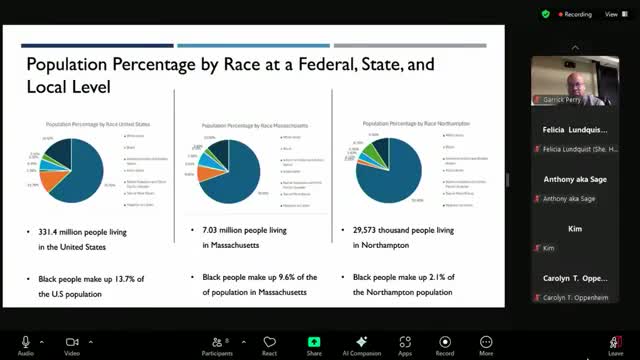Census data reveals racial disparities in income and poverty in Northampton Massachusetts
April 02, 2025 | Northampton City, Hampshire County, Massachusetts
Thanks to Scribe from Workplace AI , all articles about Massachusetts are free for you to enjoy throughout 2025!

This article was created by AI using a video recording of the meeting. It summarizes the key points discussed, but for full details and context, please refer to the video of the full meeting. Link to Full Meeting
The presentation began with a breakdown of racial demographics, illustrating that Black individuals constitute only 2.1% of Northampton's population, translating to approximately 915 people. This figure is notably lower than the national average of 13.7% and the state average of 9.6%. Such demographic disparities raise questions about representation and equity in local governance and community resources.
Income inequality was another focal point, with the median household income for Black families in Massachusetts reported at $54,835 in 2020, significantly lower than the $74,912 for white households. By 2023, while the income for Black households increased to $73,976, it remained $31,000 less than that of white households, indicating persistent economic disparities.
The meeting also addressed poverty rates, revealing that 21.9% of Black residents in Northampton live below the poverty line, a figure that surpasses both state and national averages. In contrast, the overall poverty rate in Northampton stands at 12.5%. This alarming statistic underscores the urgent need for targeted interventions to address economic inequities.
Housing issues were further explored, with data showing that Black homeownership rates are significantly lower than those of white residents. Nationally, only 7.9% of Black individuals own homes, compared to 73.1% of white individuals. In Northampton, homeownership rates were reported at 57.7%, slightly below the state average of 60.4%. The meeting highlighted the challenges of cost burden, where over half of Black households in Northampton spend more than 50% of their income on housing-related costs, a stark contrast to lower rates in nearby Springfield.
The discussions at the Northampton Reparations Study Commission reflect a growing recognition of the systemic barriers faced by the Black community in the region. As the commission continues its work, the data presented serves as a crucial foundation for understanding the socio-economic landscape and the need for reparative measures to address historical injustices. The commission's next steps will likely involve formulating actionable recommendations aimed at fostering equity and improving the living conditions of marginalized communities in Northampton.
Converted from Northampton Reparations Study Commission | April 1, 2025 meeting on April 02, 2025
Link to Full Meeting
Comments
View full meeting
This article is based on a recent meeting—watch the full video and explore the complete transcript for deeper insights into the discussion.
View full meeting


